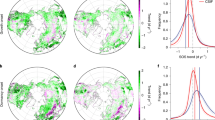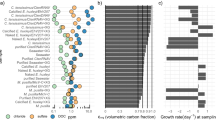Abstract
Photosynthesis of Antarctic phytoplankton is inhibited by ambient ultraviolet (UV) radiation during incubations1,2,3,4, and the inhibition is worse in regions beneath the Antarctic ozone ‘hole’4. But to evaluate such effects, experimental results on, and existing models of, photosynthesis5,6,7 cannot be extrapolated directly to the conditions of the open waters of the Antarctic because vertical mixing of phytoplankton alters UV exposure and has significant effects on the integrated inhibition through the water column2,8,9. Here we present a model of UV-influenced photosynthesis in the presence of vertical mixing, which we constrain with comprehensive measurements from the Weddell-Scotia Confluence during the austral spring of 1993. Our calculations of photosynthesis integrated through the water column (denoted PT) show that photosynthesis is strongly inhibited by near-surface UV radiation. This inhibition can be either enhanced or decreased by vertical mixing, depending on the depth of the mixed layer. Predicted inhibition is most severe when mixing is rapid, extending to the lower part of the photic zone. Our analysis reveals that an abrupt 50% reduction in stratospheric ozone could, in the worst case, lower PT by as much as 8.5%. However, stronger influences on inhibition can come from realistic changes in vertical mixing (maximum effect on PT of about ±37%), measured differences in the sensitivity of phytoplankton to UV radiation (±46%) and cloudiness (±15%).
This is a preview of subscription content, access via your institution
Access options
Subscribe to this journal
Receive 51 print issues and online access
$199.00 per year
only $3.90 per issue
Buy this article
- Purchase on Springer Link
- Instant access to full article PDF
Prices may be subject to local taxes which are calculated during checkout


Similar content being viewed by others
References
Lubin, D.et al. Acontribution toward understanding the biospherical significance of Antarctic ozone depletion. J. Geophys. Res. 97, 7817–7828 (1992).
Helbling, E. W., Villafañe, V. & Holm-Hansen, O. in Ultraviolet Radiation in Antarctica: Measurements and Biological Effects(eds Weiler, C. S. & Penhale, P. A.) 207–227 (Am. Geophys. Union, Washington DC, (1994).
Vernet, M., Brody, E. A., Holm-Hansen, O. & Mitchell, B. G. in Ultraviolet Radiation in Antarctica: Measurements and Biological Effects(eds Weiler, C. S. & Penhale, P. A.) 143–158 (Am. Geophys. Union, Washington DC, (1994).
Smith, R. C.et al. Ozone depletion: Ultraviolet radiation and phytoplankton biology in Antarctic waters. Science 255, 952–959 (1992).
Neale, P. J., Lesser, M. P. & Cullen, J. J. in Ultraviolet Radiation in Antarctica: Measurements and Biological Effects(eds Weiler, C. S. & Penhale, P. A.) 125–142 (Am. Geophys. Union, Washington DC, (1994).
Arrigo, K. R. Impact of ozone depletion on phytoplankton growth in the Southern Ocean: large-scale spatial and temporal variability. Mar. Ecol. Prog. Ser. 114, 1–12 (1994).
Boucher, N. & Prézelin, B. B. An in situ biological weighting function for UV inhibition of phytoplankton carbon fixation in the Southern Ocean. Mar. Ecol. Prog. Ser. 144, 223–236 (1996).
Smith, R. C. & Baker, K. S. in The Role of Solar Ultraviolet Radiation in Marine Ecosystems(ed. Calkins, J.) 509–537 (Plenum, New York, (1982).
Neale, P. J., Cullen, J. J. & Davis, R. F. Inhibition of marine photosynthesis by ultraviolet radiation: Variable sensitivity of phytoplankton in the Weddell-Scotia Confluence during the austral spring. Limnol. Oceanogr.(in the press).
Behrenfeld, M. J., Chapman, J. W., Hardy, J. T. & Lee, H. I Is there a common response to ultraviolet-b radiation by marine phytoplankton. Mar. Ecol. Prog. Ser. 102, 59–68 (1993).
Cullen, J. J., Neale, P. J. & Lesser, M. P. Biological weighting function for the inhibition of phytoplankton photosynthesis by ultraviolet radiation. Science 258, 646–650 (1992).
Boucher, N. P. & Prézelin, B. B. Spectral modeling of UV inhibition of in situ Antarctic primary production using a field derived biological weighting function. Photochem. Photobiol. 64, 407–418 (1996).
Veth, C. The evolution of the upper water layer in the marginal ice zone, austral spring 1988, Scotia-Weddell Sea. J. Mar. Syst. 2, 451–464 (1991).
Nelson, D. M. & Smith, W. O. J Sverdrup revisited: Critical depths, maximum chlorophyll levels, and the control of Southern Ocean productivity by the irradiance-mixing regime. Limnol. Oceanogr. 36, 1650–1661 (1991).
Cullen, J. J. & Lesser, M. P. Inhibition of photosynthesis by ultraviolet radiation as a function of dose and dosage rate: Results for a marine diatom. Mar. Biol. 111, 183–190 (1991).
Franks, P. J. S. & Marra, J. Asimple new formulation for phytoplankton photoresponse and an application in a wind-driven mixed-layer model. Mar. Ecol. Prog. Ser. 111, 145–153 (1994).
Yamazaki, H. & Kamykowski, D. The vertical trajectories of motile phytoplankton in a wind-mixed water column. Deep-Sea Res. 38, 219–241 (1991).
Anis, A. & Moum, J. N. Surface wave-turbulence interactions: scaling ε(z) near the sea surface. J. Phys. Oceanogr. 25, 2025–2045 (1995).
Prézelin, B. B., Boucher, N. P. & Smith, R. C. in Ultraviolet Radiation in Antarctica: Measurements and Biological Effects(eds Weiler, C. S. & Penhale, P. A.) 159–186 (Am. Geophys. Union, Washington DC, (1994).
Helbling, E. W., Villafañe, V., Ferrario, M. & Holm-Hansen, O. Impact of natural ultraviolet radiation on rates of photosynthesis and on specific marine phytoplankton species. Mar. Ecol. Prog. Ser. 80, 89–100 (1992).
Zepp, R. G. & Cline, D. M. Rates of direct photolysis in aquatic environment. Environ. Sci. Technol. 11, 359–366 (1977).
Murray, A. G. & Jackson, G. A. Viral dynamics II: a model of the interaction of ultraviolet light and mixing processes on virus survival in seawater. Mar. Ecol. Prog. Ser. 102, 105–114 (1993).
Vincent, W. F. & Roy, S. Solar ultraviolet-B radiation and aquatic primary production: damage, protection and recovery. Environ. Rev. 1, 1–12 (1993).
Morel, A. Available, usable, and stored radiant energy in relation to marine photosynthesis. Deep-Sea Res. 25, 673–688 (1978).
Cullen, J. J. & Neale, P. J. in The Effects of Ozone Depletion on Aquatic Ecosystems(ed. Häder, D.-P.) 97–118 (Landes, Austin, (1997).
Gregg, W. W. & Carder, K. L. Asimple spectral solar irradiance model for cloudless maritime atmospheres. Limnol. Oceanogr. 35, 1657–1675 (1990).
Davis, R. F., Lazin, G., Bartlett, J., Ciotti, A. & Stabeno, P. Remote sensing of a pigment patch in the southeastern Bering Sea. Proc. SPIE 2963, 654–657 (1997).
Prieur, L. & Sathyendranath, S. An optical classification of coastal and oceanic waters based on the specific absorption curves of phytoplankton pigments, dissolved organic matter, and other particulate materials. Limnol. Oceanogr. 26, 671–689 (1981).
Sakshaug, E., Johnsen, G., Andersen, K. & Vernet, M. Modeling of light-dependent algal photosynthesis and growth: experiments with Barents Sea diatoms Thalassiosira nordenskioeldii and Chaetoceros furcellatus. Deep-Sea Res. 38, 415–430 (1991).
Denman, K. L. & Gargett, A. E. Time and space scales of vertical mixing and advection of phytoplankton in the upper ocean. Limnol. Oceanogr. 28, 801–815 (1983).
Acknowledgements
We thank members of the science team, officers and crew of the Nathaniel B. Palmer cruise NBP93-6 for assistance, W. Helbling, C. Gallegos, J. Christian, M. Lewis and B. Nieke for comments, D. Kelley for discussions of vertical mixing, M. Lesser for use of his spectroradiometers and P. Franks for providing his version of the mixing model. This work was supported by the NSF Office of Polar Programs, NSERC, NASA, and ONR Ocean Optics.
Author information
Authors and Affiliations
Corresponding author
Rights and permissions
About this article
Cite this article
Neale, P., Davis, R. & Cullen, J. Interactive effects of ozone depletion and vertical mixing on photosynthesis of Antarctic phytoplankton. Nature 392, 585–589 (1998). https://doi.org/10.1038/33374
Received:
Accepted:
Issue Date:
DOI: https://doi.org/10.1038/33374
This article is cited by
-
Light history modulates growth and photosynthetic responses of a diatom to ocean acidification and UV radiation
Marine Life Science & Technology (2022)
-
Inclusion of ionizing radiation in a mathematical model for photosynthesis
Radiation and Environmental Biophysics (2021)
-
UV radiation limited the expansion of cyanobacteria in early marine photic environments
Nature Communications (2018)
-
Optode use to evaluate microbial planktonic respiration in oligotrophic ecosystems as an indicator of environmental stress
Aquatic Sciences (2017)
-
The effect of ozone and aerosols on the surface erythemal UV radiation estimated from OMI measurements
Asia-Pacific Journal of Atmospheric Sciences (2013)
Comments
By submitting a comment you agree to abide by our Terms and Community Guidelines. If you find something abusive or that does not comply with our terms or guidelines please flag it as inappropriate.



